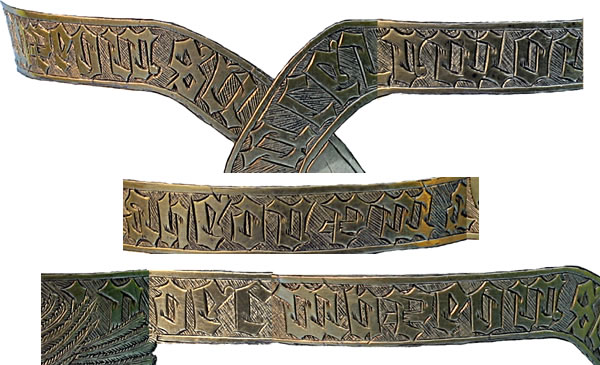These images were sent in by a visitor to Omniglot from Romania and appear on a Romanian cup dating from about 1500. The inscription is in Gothic-style letters, but has so far resisted decipherment and may be encrypted or in another language such as Arabic or Romani.

Close up of the inscription

Any suggestions?-style
Not ‘Gothic’, but ‘Textura’, or ‘blackletter’. At first I thought you’d found the lost Gothic-speakers of the Crimea…
Anyway. As near as I can read it, starting from the bottom of the V…
ucelrmoiahedrpma [eagle] ..decmhpeoirsu
The ‘h’s I’m not sure about; they’re my best guess.
It doesn’t look like it makes much sense in any language. Unless it’s ciphered, of course. Or maybe it’s just decorative.
Got out my calligraphy book. Agree this is Textura script I read (with some doubt).
*eoirsh nceirmoi (uceirmoi?)
ahedrapwa
***decwhpeoirs (decwnpeoirs?)
Perhaps ‘(p)eoirsh’ is a word or a name?
If it is from 1500 and Romania, written in blackletter, the language may be Latin, German or Hungarian. Romanian is highly improbable (it would be the earliest known inscription in the language using a form of Latin alphabet, which would make the cup extremely well known). Arabic or Romani are hardly plausible.
I would try to analyse the apparent C as R and the apparent R as long S and U for H, in order to get more German-looking
II reiſwolau edſpwa in der wupeoiſs II
Doesn’t make sense nevertheless.
No idea for a reading, but an observation: what others have been giving the value /i/ may well be an “r rotunda”, aspecial form that follows rounded letters in blackletter styles. (It persists as the unusual shape of minuscule in many people’s cursive handwriting.)
All i can say it is definitely not Arabic.
However, let’s not forget that the “U” and “V” letters were interchangeable (like writing Jesus as JESVS for example), as well the “I” and “J”.
The “W” here can be as well “M”.
Just a shot in the dark, the middle strip (middle picture) might be something like: aveovema, maybe?
One more thing to notice here, the style of the script (and I don’t know anything about Gothic-like styles), with the edges of the letters and the endings, looks like a Hebrew style. Not to say the language here is Hebrew or Hebrew-related, but we might have some Jewish connection in view?
TJ-
I think the apparent similarities to what is usually seen as a Hebrew look are due to the fact that both, with their segmented (or “broken”) strokes and heavy modulation, i.e. contrast between thick and thin strokes, are the result of using a fairly broad nibbed pen (or quill or calamus).
@Christopher: yes true. Forgot that point about the pen used. Did you notice in the 3rd strip, toward the end of the line we have successive two E’s but their design is kinda different significantly. Does that bear any point?
If the style and the text are “gothic” for sure, then we might refer to gothic language as well?
So much confusion! Those poor Goths, being mistaken for those poor Goths. And not to forget those poor Goths.
TJ: If what you’re talking about is what I think it is, then it’s “…pe…”
The bottom of the bowl of the ‘p’ crossing the descender is a common distinguishing feature of the letter going back to protogothic script.
And ‘Gothic’ as a family of script, including rotunda, textura, fractura and bastarda, is a retroactive name given to them in analogy with the term as applied to architecture and art. And that was related to the Gothic peoples and language only insofar as they were seen as synonyms for barbaric and unrefined, as opposed to Graeco-Roman classicism. There’s no other connection between Gothic script and the Gothic language, and the script for that devised by Wulfila, based on Greek.
It looks like the eagle from the House of Basarab crest. Time and location matches. Not sure about the inscription…